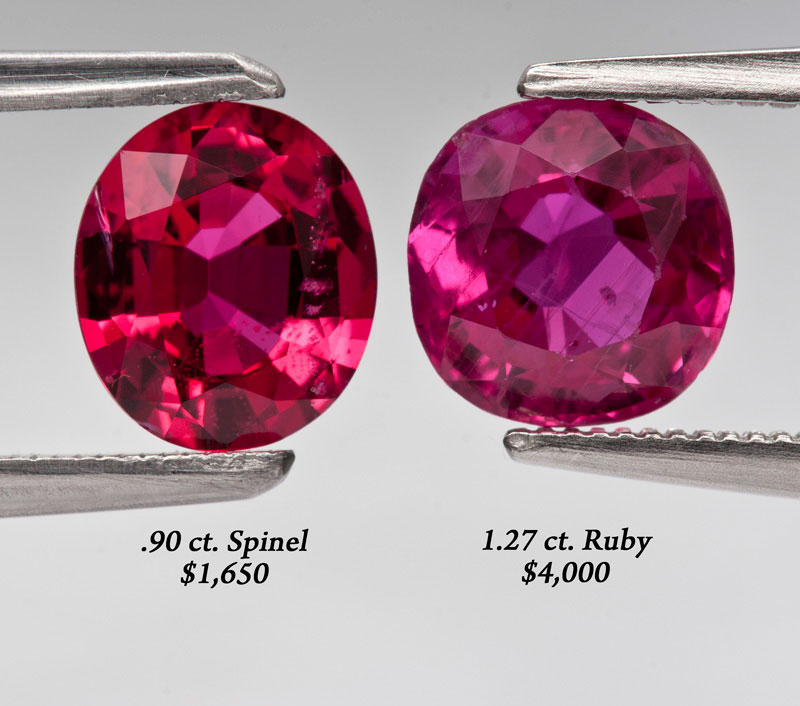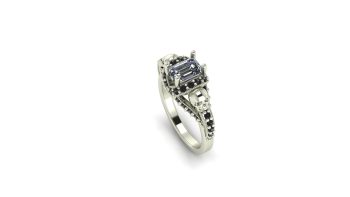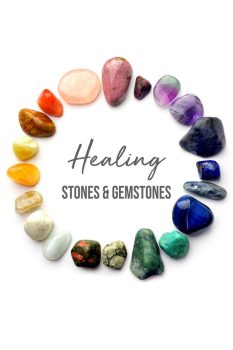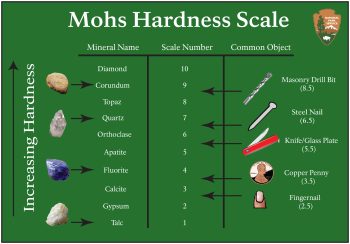Ruby Vs Spinel
Ruby And Spinel are two of the most sought after gemstones in the history of mankind. They are two of the harder stones on the planet. The red version of spinel has also been incorrectly called ruby before chemical tests were available to discern the two. In this post, we will discuss the history of the two stones, their physical properties, price, and how to tell the difference between the two.
What Is Ruby
A ruby is a precious gemstone that belongs to the corundum family. It is known for its vibrant red color, which ranges from deep crimson to a lighter pinkish hue. Rubies are highly valued and sought after for their beauty and rarity. They are often used in jewelry, particularly in engagement rings and necklaces. Rubies have been treasured for centuries and have a rich history and cultural significance in many different cultures around the world.
Rubies are formed deep within the Earth’s crust, under intense heat and pressure. They are typically found in metamorphic rocks, such as marble and schist. The red color of rubies is caused by the presence of the element chromium. The more chromium present in the gemstone, the deeper and more intense the red color will be.
In addition to their aesthetic appeal, rubies are also believed to possess various metaphysical properties. They are said to symbolize passion, love, and courage. In some cultures, rubies are thought to bring good fortune and protect against evil spirits. They are also associated with vitality and energy. Whether you are a gemstone enthusiast or simply appreciate the beauty of these exquisite gems, a ruby is a truly remarkable and captivating gemstone.

History Of Ruby
Rubies have a rich history dating back thousands of years. These precious gemstones have captivated people’s imaginations and adorned the crowns of kings and queens throughout history. The word “ruby” comes from the Latin word “ruber,” meaning red, which perfectly describes the vibrant color of this gemstone. Rubies have been prized for their beauty and rarity, making them highly sought after by collectors and jewelry enthusiasts alike.
The earliest known records of rubies can be traced back to ancient civilizations such as the Egyptians and the Romans. They believed that rubies held magical powers and offered protection against evil spirits. In fact, rubies were often buried with the deceased to ensure a safe journey to the afterlife. The popularity of rubies continued to grow during the Middle Ages, where they were believed to bring wealth and success to their owners.
One of the most famous rubies in history is the Black Prince’s Ruby, which is actually a spinel. This gemstone is set in the Imperial State Crown of England and has a fascinating story behind it. It was believed to have been worn by Henry V in his helmet during the Battle of Agincourt in 1415. The Black Prince’s Ruby has since become a symbol of power and prestige.
Today, rubies continue to be highly valued and cherished. They are often featured in high-end jewelry pieces and are considered one of the four precious gemstones, along with diamonds, emeralds, and sapphires. Rubies are also the birthstone for the month of July, making them a popular choice for those born in that month.
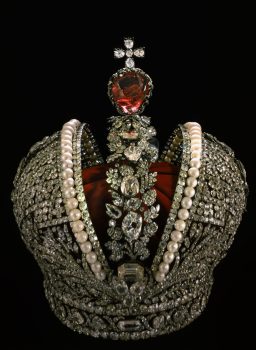
Ruby Physical Properties & Chemical Composition
Ruby belongs to the corundum family, which also includes sapphires. The physical properties of ruby make it a highly sought-after gemstone in the jewelry industry. Ruby has a hardness of 9 on the Mohs scale, making it one of the hardest gemstones. Its refractive index ranges from 1.76 to 1.78, giving it excellent brilliance and sparkle.
Chemically, ruby is composed of aluminum oxide with traces of chromium. It is the presence of chromium that gives ruby its characteristic red color. The amount of chromium determines the shade of red, with higher concentrations resulting in a deeper red hue. Ruby is also known for its fluorescence under ultraviolet light, emitting a red glow.
In addition to its beauty, ruby is also valued for its durability. Measuring 9 on the Mohs scale, it has a high resistance to scratching and is not easily damaged. However, it is important to care for ruby jewelry properly to maintain its luster and brilliance. Regular cleaning with mild soap and water and avoiding harsh chemicals or abrasive materials will help preserve the beauty of ruby for years to come.
Ruby Color Range
Ruby is a gemstone known for its vibrant red color. The color range of rubies can vary from a deep, intense red to a lighter, pinkish hue. The most valuable rubies are those with a rich, blood-red color, often referred to as “pigeon’s blood” red. These rubies are highly sought after and command high prices in the gemstone market.
In addition to the classic red color, rubies can also be found in shades of pink and purple. These variations in color are due to the presence of different impurities and trace elements in the gemstone. For example, pink rubies may contain traces of chromium, while purple rubies may have traces of iron.
When choosing a ruby, it is important to consider personal preference as well as the desired color intensity. Some individuals may prefer a deep red ruby, while others may prefer a lighter, pinkish hue. Ultimately, the color range of rubies offers a variety of options to suit different tastes and styles.
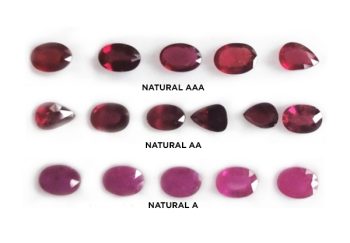
What Is Spinel
Spinel is a gemstone that is known for its vibrant colors and exceptional brilliance. It is a mineral that belongs to the spinel group, which also includes other gemstones like ruby and sapphire. Spinel is often mistaken for other gemstones due to its similar appearance, but it has its own unique characteristics that set it apart.
Spinel is also known for its exceptional brilliance. It has a high refractive index, which means that it reflects light in a way that gives it a dazzling sparkle. This makes spinel a popular choice for gemstone enthusiasts who appreciate its beauty and brilliance.
Spinel is is reputed for its durability and strength. It is a popular choice for jewelry due to its ability to withstand everyday wear and tear. Spinel ranks 8 on the Mohs scale of hardness, making it a tough and resilient gemstone. Its durability is further enhanced by its excellent resistance to scratching and chipping. Whether set in a ring, necklace, or bracelet, spinel is a reliable and long-lasting gemstone option.
In addition to its durability, spinel also boasts a high refractive index, which gives it a brilliant sparkle and luster. This makes it an attractive choice for those seeking a gemstone with exceptional visual appeal. It is available in a wide range of colors, including red, blue, pink, and purple, allowing for versatile and stunning jewelry designs.
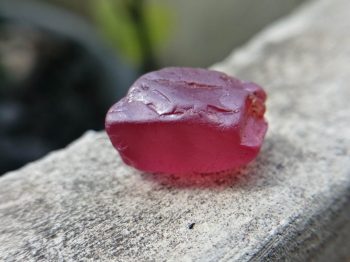
History Of Spinel
Spinel has a rich history dating back centuries. Believed to have been first discovered in ancient Sri Lanka, spinel quickly gained popularity among royalty and the elite. Its mesmerizing hues, ranging from deep reds to vibrant blues, made it a coveted gemstone throughout history. Today, spinel continues to be highly valued for its beauty and rarity, making it a cherished gemstone in the world of jewelry.
Throughout the ages, spinel has been associated with various cultures and civilizations. In ancient times, it was often mistaken for other gemstones, such as rubies and sapphires, due to its similar appearance. However, spinel’s unique properties and characteristics eventually set it apart as a distinct gemstone. It was highly prized by the ancient Romans, who believed that spinel possessed protective qualities and brought good fortune.
During the medieval period, spinel gained popularity in Europe, particularly among the nobility. It was frequently used in the creation of regal jewelry, including crowns, tiaras, and brooches. The vibrant red spinel, known as “balas ruby,” was especially favored by monarchs and aristocrats. Its association with royalty continued into the Renaissance era, with spinel adorning the jewelry of prominent figures such as Queen Elizabeth I of England.
In modern times, spinel has become a sought-after gemstone in its own right. Its unique colors, durability, and affordability have made it a popular choice for both fine jewelry and fashion accessories. With its rich history and timeless beauty, spinel continues to captivate and enchant gemstone enthusiasts around the world. Whether set in an elegant necklace or a dazzling ring, spinel is sure to add a touch of sophistication and allure to any jewelry collection.
Spinel Physical Properties & Chemical Composition
Spinel is a mineral that belongs to the spinel group, which includes other minerals such as gahnite and hercynite. It is composed of magnesium aluminum oxide and belongs to the cubic crystal system. Its refractive index ranges from 1.712 to 1.736, giving it a high level of brilliance and sparkle.
One of the distinguishing features of spinel is its pleochroism, which means that it can display different colors when viewed from different angles. This optical phenomenon adds to the gemstone’s allure and makes it a popular choice for jewelry. Additionally, spinel is often used as a substitute for other gemstones, such as ruby and sapphire, due to its similar appearance and affordability.
In terms of its physical properties, spinel has a specific gravity ranging from 3.54 to 4.00. It has a vitreous to subadamantine luster, giving it a polished and glossy appearance. Spinels can be found in various locations around the world, including Myanmar, Sri Lanka, and Tanzania. Overall, spinel is a versatile and beautiful gemstone that is highly valued in the world of jewelry.
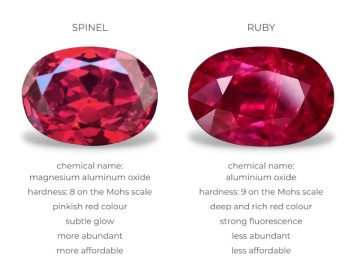
Spinel Color Range
Spinel is a gemstone known for its vibrant colors. It comes in a wide range of hues, from intense reds and pinks to deep blues and purples. The color of spinel is determined by the presence of certain chemical elements, such as iron and chromium. The most prized color for spinel is a vivid red, often referred to as “ruby spinel.” However, spinel can also be found in shades of pink, purple, blue, and even black. Its versatility in color makes spinel a popular choice for jewelry, as it can be matched with different outfits and styles. Whether you prefer a bold red spinel or a subtle pink spinel, there is a color to suit every taste.

Ruby Vs Spinel – Price Difference
Ruby and spinel are both gemstones that are highly valued for their beauty and rarity. However, there is a significant difference in price between in Ruby Vs Spinel.
Ruby, known for its vibrant red color, is one of the most expensive gemstones in the world. Its price is determined by several factors, including its color, clarity, cut, and carat weight. The finest rubies are those that have a deep red hue, often referred to as “pigeon blood” red. These rubies command the highest prices in the market. Additionally, rubies that are free from any visible inclusions or flaws are considered more valuable. The size of the ruby also affects its price, with larger rubies being more expensive. Overall, the price of a ruby can range from a few hundred dollars per carat to several thousand dollars per carat, depending on its quality.
On the other hand, spinel is a gemstone that is often mistaken for ruby due to its similar appearance. However, spinel is generally more affordable than ruby. While spinel can also come in a range of colors, including red, blue, and pink, it is the red spinel that is most often compared to ruby. The price of spinel is influenced by factors such as its color, clarity, cut, and carat weight. However, even the finest spinels are generally priced lower than rubies of similar quality. This makes spinel a more accessible option for those who desire a red gemstone but have a limited budget.
Lab Grown Ruby & Spinel
Lab grown rubies and spinels are synthetic gemstones that are created in a laboratory environment using advanced technology. These lab-grown gemstones have the same chemical composition and physical properties as their natural counterparts, but they are created in a much shorter time frame.
One of the main advantages of lab-grown rubies and spinels is their affordability. Compared to natural gemstones, lab-grown varieties are significantly less expensive. This makes them a popular choice for those who want to own a beautiful and durable gemstone without breaking the bank. You can find lab spinels and rubies for less than $10 a carat on the smaller stones.
Another benefit of lab-grown rubies and spinels is their ethical sourcing. Unlike natural gemstones, which are often mined under questionable conditions, lab-grown gemstones are created in a controlled environment without any harm to the environment or human rights concerns.
How To Tell The Difference Between Ruby Vs Spinel
Ruby Vs Spinel can be easily confused due to their similar appearance. However, there are a few key differences that can help you tell them apart.
Firstly, let’s talk about their color. Ruby is known for its vibrant red hue, ranging from pinkish-red to deep blood-red. On the other hand, spinel comes in a variety of colors, including red, but also blue, pink, purple, and even black. So, if you come across a gemstone with a color other than red, chances are it’s spinel and not ruby.
Ruby and Spinel are two gemstones that exhibit different fluorescence under certain lighting conditions. Some rubies fluoresce with a red or pinkish-red glow under a black light.
When exposed to UV light, some spinels exhibit fluorescence, emitting a range of colors such as pink, orange, or even a bright blue. It’s important to note that not all rubies and spinels exhibit fluorescence. The presence and intensity of fluorescence can vary from stone to stone. Gemologists and jewelers often use UV light to identify and assess the fluorescence of these gemstones. While it is not a magic bullet, it can help in discerning between ruby vs spinel
Lastly, it’s worth noting that ruby is a rarer gemstone compared to spinel. This rarity in Ruby Vs Spinel translates to a higher price tag for rubies. So, if you come across a gemstone that is relatively affordable and looks like a ruby, it’s more likely to be spinel.
Looking For Spinel or Ruby Jewelry?
We create custom jewelry. That means we source any stones for each individual project. As a result you will get the spinel or ruby that is perfect for your piece. Clink the links to see our bridal jewelry or custom pendants.
Then, contact us with your idea for a custom jewelry creation featuring ruby or spinel.
